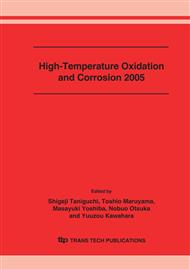[1]
H.L. Solberg, G.A. Hawkins and A.A. Potter, Transactions of the American Society of Mechanical Engineers, 1942, 64, 303.
Google Scholar
[2]
F. Eberle and C.H. Anderson, Journal of Engineering Power, 1962, 84, 223.
Google Scholar
[3]
P J Ennis and W J Quadakkers in Materials for Advanced Power Engineering 2002, eds J Lecomte-Beckers, M Carton, F Schubert and P J Ennis, pub Forschungszentrum Julich GmbH 2002 pp.1131-1142.
Google Scholar
[4]
S Osgerby and A T Fry, EPRI conf, Oct (2004).
Google Scholar
[5]
M Ueda, M Nanko, K Kawamura and T Maruyama, in Proc 3rd Int Workshop on Environmental Degradation in Advanced Energy Systems, eds J F Norton, N J Simms, W T Bakker and I G Wright, pub Science Reviews 2002, 109.
Google Scholar
[6]
M G C Cox, B McEnaney and V D Scott, Nature Physical Science, 1972 237 140.
Google Scholar
[7]
C T Fujii and R A Meussner, Journal of the Electrochemical Society, 1964, 111, 1215.
Google Scholar
[8]
Y Ikeda and K Nii, Oxidation of Metals, 1978, 12, 487.
Google Scholar
[9]
T Ericsson, Oxidation of Metals, 1970, 2, 173.
Google Scholar
[10]
P L Surman and J E Castle, Corrosion Science 1969 9 771.
Google Scholar
[11]
D Caplan and M Cohen, Journal of the Electrochemical Society, 1961 108 438.
Google Scholar
[12]
B B Ebbinghaus, Combustion and Flame 1993, 93, 119.
Google Scholar
[13]
J Ehlers and W J Quadakkers, Report Forschungszentrum Julich, Julich, ISSN 0944-2952, June (2001).
Google Scholar
[14]
T Norby, Journal de Physique IV, Colloque C9, 1993, 99 Figure 1. Corrosion of steel bars in contact with steam at 593 °C for 200, 500, 1000 and 2000 h (after Ref [1]) Figure 2. Correlation between Empirical Cr Equivalent Model and Experimental Data (a) 600 °C (b) 650 °C (after Ref [4]).
Google Scholar
[10] [20] [30] [40] 0 10 20 30 40 50 Cr Equivalent Specific Mass Change, mg cm -2 600 °C 1000 h 600 °C 3000 h 600 °C 5000 h 1000 h model 3000 h model 5000 h model.
Google Scholar
[10] [20] [30] [40] 0 10 20 30 40 50 Cr Equivalent Specifit Mass Change, mg cm-2 650 °C 1000 h 650 °C 3000 h 650 °C 5000 h 1000 h model 3000 h model 5000 h model (a) (b) (c) (a) (b) (c) Figure 3 SEM images of oxide scales formed after exposure to steam atmosphere at 650 °C for 300 h (a) P92 (b) Alloy 122 (c) X19 (a) (b) Figure 4 Elemental distribution map of P92 exposed for 3000 h at 650 °C (a) oxygen (b) silicon Figure 5 Elemental distribution in alloys exposed to steam at 650 °C for 1000 h (a) P92 (b) Alloy 122 (c) X19.
DOI: 10.1016/j.cja.2016.12.031
Google Scholar
[1] [2] [3] [4] [5] 0 50 100 150 200 250 Distance from Surface, µµµµm Normalised Concentration of Element Cr Mn Mo W Magnetite/Spinel Interface Spinel/Alloy Interface.
Google Scholar
[1] [2] [3] [4] [5] 0 20 40 60 80 100 120 Distance from Surface, µµµµm Normalised Concentration of Element Cr Mn Mo W Magnetite/Spinel Interface Spinel/Alloy Interface.
Google Scholar
[1] [2] [3] [4] [5] 0 10 20 30 40 50 Distance from Surface, µµµµm Normalised Concentration of Element Cr Mn Mo Magnetite/Spinel Interface Spinel/Alloy Interface (a) (b) (c).
Google Scholar
[1] [2] [3] [4] [5] 0 50 100 150 200 250 Distance from Surface, µµµµm Normalised Concentration of Element Cr Mn Mo W Magnetite/Spinel Interface Spinel/Alloy Interface.
Google Scholar
[1] [2] [3] [4] [5] 0 20 40 60 80 100 120 Distance from Surface, µµµµm Normalised Concentration of Element Cr Mn Mo W Magnetite/Spinel Interface Spinel/Alloy Interface.
Google Scholar
[1] [2] [3] [4] [5] 0 10 20 30 40 50 Distance from Surface, µµµµm Normalised Concentration of Element Cr Mn Mo Magnetite/Spinel Interface Spinel/Alloy Interface (a) (b) (c) Figure 6 Schematic representation of Dissociation Mechanism for Steam Oxidation I II III IV Fe3O4 Void M3O4 H2O H H2O Fe++ Fe++ H2 I II III IV Fe3O4 Void M3O4 H2O H H2O Fe++ Fe++ H2.
DOI: 10.1016/j.chemgeo.2017.04.010
Google Scholar


